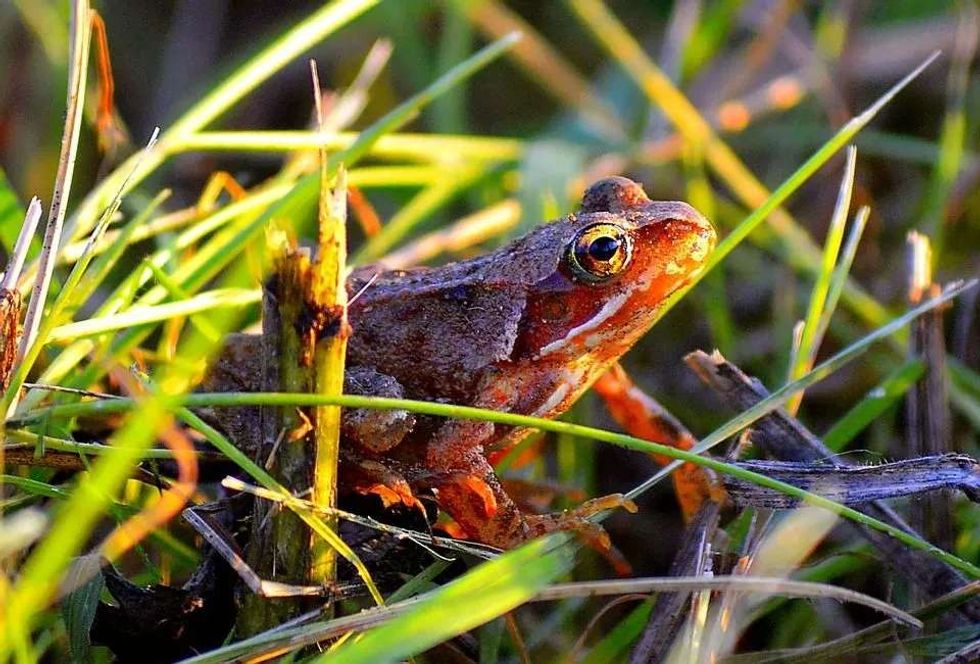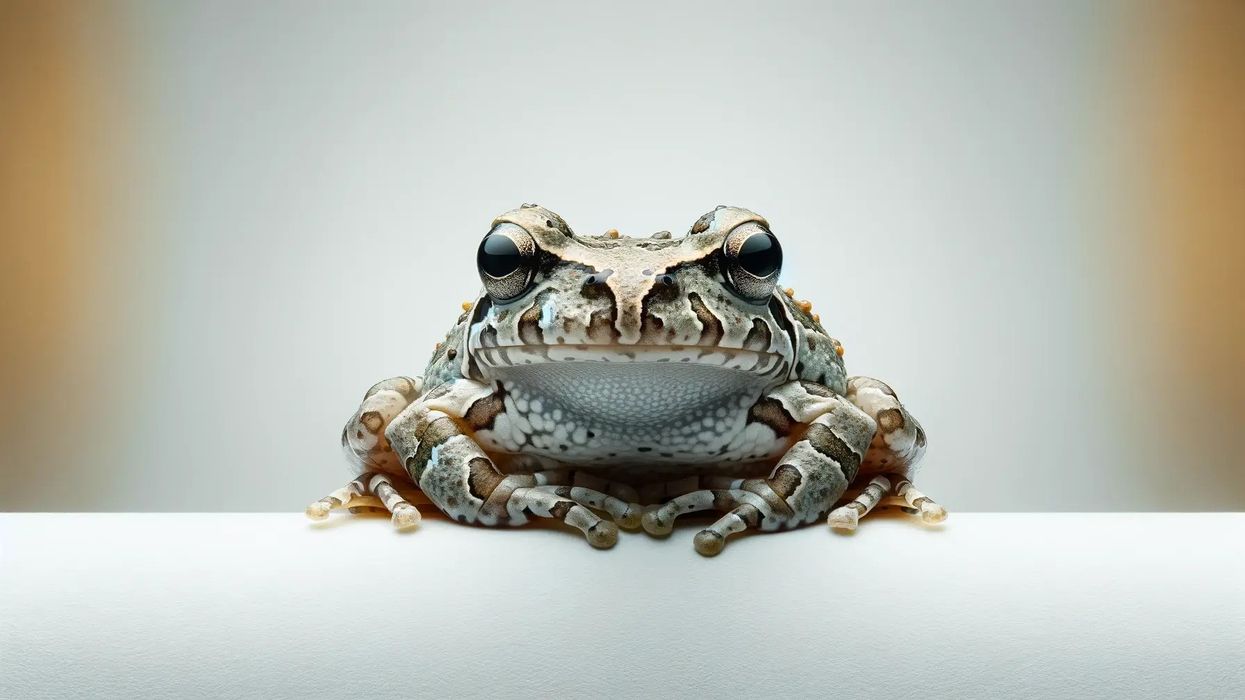Common frogs are found in the continent of Europe, from Great Britain to central Russia. The common frog (Rana temporaria) is also known as the grass common green frog or the russet frog.
It is a semi-aquatic amphibian which means it can survive on land and water, but it prefers to stay in regions near a source of water. The common frog has three distinct life stages, it starts as aquatic larva, then becomes a terrestrial juvenile, and then reaches adulthood.
Common frogs are not same as Bufo bufo, the common toad, they are a different species altogether.
Common frogs are born with different colors from olive green to gray-brown, brown, olive-brown, gray, yellow, pink, red, and rufous. They can adapt the color (lighten or darken) of their skin to match their surroundings.
They also have dark patches on their backs, stripes on their hind legs, and a dark mask behind their eyes. The common frog has brown eyes with horizontal pupils and transparent inner eyelids to protect its eyes while swimming.
Male and female common frogs can be differentiated by their size as females are larger than males. Common frogs can breathe through their lungs and their skin.
A loss of habitat is one of the major causes of the decline in the current common frog population. The Amphibian and Reptile Conservation Trust (ARC) works towards the conservation of amphibians and reptiles including this species.
Read on to discover some of the most interesting common European frog facts. After reading about the common tree frog, do check out our other articles on the pool frog and the frilled lizard.
Common Frog Interesting Facts
What type of animal is a common frog?
The common frog (Rana temporaria) is a type of frog that belongs to the amphibians category. As its name suggests, it is commonly found in the Eurasian region, including in the United Kingdom and Russia. In semi-urban and urban areas, garden ponds are the most important habitat for the common frog to survive and thrive in.
What class of animal does a common frog belong to?
The common frog (scientific name: Rana temporaria) belongs to the amphibian class of animals. It is a semi-aquatic animal which means it lives on the land and in water too.
How many common frogs are there in the world?
The exact numbers of common frogs living are difficult to find. However, a loss of habitat is one of the major reasons for the species' declining numbers. Efforts are being made to stop this from happening, including creating more garden ponds for their habitat.
Where does a common frog live?
A common frog can often be found near a freshwater body. They live in marshes or in long grasses and they are found in a number of European countries including the UK and Russia. They are sometimes found in the snow-covered Alps too! Garden ponds are an extremely important habitat for common frogs.
What is a common frog's habitat?
Common frogs are often found in damp places around garden ponds, among marshes, and in long grasses. All of these places are important for common frogs.
They remain highly active most days, except when hibernating during winter. They are also found in snow-covered regions in northern Europe, where they are known to be trapped under snow for almost nine months of the year. They are known to come out of hibernation around February when temperatures begin rising.
Common frogs are known to travel to garden ponds and spawn once the climate becomes warmer. In the Alps, where winter lasts for a longer duration, they come out of hibernation near the beginning of June.
Who do common frogs live with?
The common frog is known to live a solitary life except during the breeding season. These frogs live by themselves for the majority of their lives.
How long does a common frog live?
The common frog has a life span of 5-10 years. Although due to the loss of their natural habitat, there has been a steep decline in their population in recent years.
How do they reproduce?
Male common frogs compete for female attention by producing a choir of croaks. Common female frogs are attracted to the male who has the loudest and longest croak.
This leads to a lot of noise being made by males. As the females enter the pond, a male will try to grab her attention by jumping onto her, while kicking the other males who are also looking to get the same female's attention.
This male frog then remains on the female's back until she lays some eggs. As these eggs are laid, the male sprays his sperm onto them.
Tadpoles hatch from these eggs after three months. The common frog breeding season happens during spring in suitable breeding ponds, or whenever the temperature reaches 57 F (14 C).
What is their conservation status?
The IUCN has listed this species as a species of Least Concern. However, the common frog population is declining rapidly all over Europe due to the loss of its natural habitat. The Amphibian and Reptile Conservation Trust (ARC) is working hard to improve the situation.
Common Frog Fun Facts
What do common frogs look like?
The common frog looks like a regular frog, as its name suggests. It has smooth, moist skin which is also sticky.
It uses this sticky skin to catch its prey. They can jump to great heights due to their long back legs and webbed feet and they have colorful skin which can darken or lighten to adapt to their surroundings. Common frogs have various bands of stripes on their back legs.
How cute are they?
Some people find them cute, and some do not. They are certainly interesting-looking creatures. From their slimy skin, which is very moist, to their croaking voice and their bulgy eyes, they are fascinating animals.
How do they communicate?
Male common frogs are known to make croaking noises to attract female common frogs. The air from their lungs is forced over the vocal cords in their throats to make this noise. Other than croaking during the mating season, these frogs are not known to take part in any vocal communication during the rest of the year.
How big is a common frog?
The common frog has an average body length of 3-5 in (7.6-12.7 cm). They are small in size and male frogs are known to be bigger than females.
How fast can a common frog move?
The common frog is known to move at a top speed of 5 mph (8 kph). They have long hind legs which make it possible for them to jump long distances.
How much does a common frog weigh?
The common frog weighs 0.04-0.05 lb (0.8 oz) on average. As a result of their small size, they are lightweight and agile.
What are their male and female names of the species?
There are no specific names for female and male common frogs. Males are simply known as male common frogs and females are known as female common frogs.
What would you call a baby common frog?
Baby common frogs are known as tadpoles, polliwogs, or tiny froglets. After tadpoles reach the age of around four months, they start to grow back legs and then front legs.
After they have absorbed their tail, they leave the water. These tiny froglets leave the water usually in the early summer or early spring, after having taken 16 weeks to grow.
What do they eat?
Most common frogs feed on a variety of insects, including insect larvae, woodlice, spiders, worms, slugs, and snails. This species can smell worms and use this scent to locate and eat them. Baby common frogs, froglets, or tadpoles are herbivores and feed on a variety of algae along with decaying plant matter.
Are they poisonous?
The common frog is not known to be poisonous, unlike its cousins the poison dart frog and the golden poison frog. Common frogs and tadpoles can hence be held in hands without any worries.
Would they make a good pet?
The common reed frog plays an important role in maintaining the ecological balance in nature. If you have a simple garden pond, you are likely to find some common frogs, froglets, and tadpoles in it.
It is important to let them thrive in their natural habitat rather than caging them. They prefer living around garden ponds so should not be kept as pets.
Did you know...
Common frogs develop faster in warmer climates in comparison to colder climates.
They are known to change the color of their skin (either darken or lightening it) according to their surroundings, similar to chameleons.
Pollution is a major reason for the loss of their natural habitat which has led to a decline in the common frog population overall.
Do common frogs live in water?
Common frogs are semi-aquatic creatures which means they can survive on land and in water. As tadpoles, they live in water.
When they grow older, they spend more time on land and as adults, they live on damp areas of land that are close to a water body. Most of the time, they live around a pond or marshy region. During spring they can travel up to 1,640 ft (500 m) away from a pond or other water source though.
When are common frogs most active?
Common frogs are nocturnal creatures which means that they are most active during the night. They are also active during summer and spring and are known to hibernate during winter.
Here at Kidadl, we have carefully created lots of interesting family-friendly animal facts for everyone to discover! Learn more about some other amphibians including the spotted salamander or the marine toad.
You can even occupy yourself at home by drawing one on our common frog coloring pages.









